Ventilation of a septic tank in a private house: is it needed + tips for arranging
The primitive cesspool was replaced by septic tanks - elements of the local sewage system, inside which biomass cleaning processes take place. Since in the process of biological decomposition of organic substances gases are released that require exit from the chamber, septic tank ventilation is installed in a private house, which ensures the removal of gases and the elimination of unpleasant odors.
You must admit that without such a device the process of wastewater treatment will be incomplete, as a result of which unpleasant odors begin to spread from the sewage system.
If the organization of ventilation is unlikely to be a problem when buying a ready-made sewage system for a home, then in the case of the construction of a septic tank yourself, you will have to make a little more effort. In this case, the ventilation system will need to be designed independently. Later in the article you will learn how to properly build a septic tank ventilation with your own hands, and what requirements and standards must be followed.
The content of the article:
Septic tank ventilation - is it needed?
Only with good ventilation can the proper operation of the entire local sewage system in a private house be achieved. In addition, ventilation of the septic tank is necessary not only for the removal of gases, but also for the further normal existence of purified biomass.
If in the same cesspool effluents only accumulate, then in the septic tank there is a natural process for their purification.

Often during installation homemade septic tanksdesigned according to the simplest schemes, they are ventilated naturally - through the slots of the hatch. Over time, this leads to the rapid spread of unpleasant odors, both in the yard and inside the house.
For those who do not know why ventilation is needed in a septic tank, we present the following goals that are achieved during the construction of ventilation:
- Providing microorganisms with oxygen.In the second compartment of the septic system are aerobic bacteria that process the waste mass after it enters the first tank. It is these bacteria that are responsible for the effective purification of water, which will be impossible if there is insufficient oxygen access to the second tank.
- Creating a safe environment. Getting into the living room, the resulting mixture of gases can be a danger to human life. The composition of the mixture includes: carbon dioxide, hydrogen sulfide, methane and phosphorus compounds. Some of them are explosive, so their accumulation can lead to serious consequences.
The absence of a fan riser can lead to a breakdown of the toilet's water seal, as a result of which the gas mixture from the septic compartment rises to the house.
So, with every flush of water, an unpleasant odor will spread throughout the house, which will bring at least discomfort to all its residents.
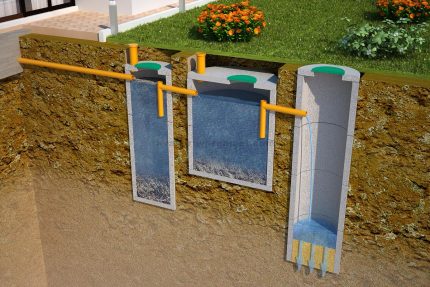
The quality of biomass purification determines the characteristics of purified water, as well as the possibility of its use in the future. Often, the liquid that has passed three degrees of purification is used to water the garden, wash the car and other household chores.
For the full course of all processes, it is necessary to ensure a direct air flow to all tanks, which can only be done by good ventilation facilities.
Types of septic tank ventilation
The ventilation pipe can be discharged both on the roof of the house and along its outer wall. The only condition is fan pipe must not be connected to a common ventilation system, otherwise the exhaust gases may be mixed by air flows and penetrate into rooms. Depending on the location of the fan riser, two types of ventilation are distinguished: internal and external.
With internal ventilation, the fan pipe located inside the house is a ventilation riser connected to plumbing fixtures in the bathroom and toilet. Water is discharged in one direction, and a mixture of gases moves to the other, discharged far beyond the house.
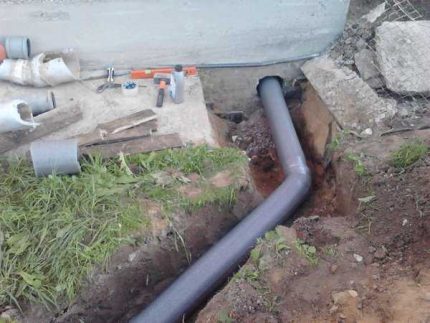
With external ventilation, the pipe is located outside the house, and is often mounted to the wall of the house. The pipe does not connect to the plumbing riser, but is immediately included in the drain pipe section located from the house to the septic tanks.
In both cases, two PVC pipes will be needed. The bottom will be installed in the overlap of the sewer system, while its upper edge must be raised to such a height that melt water can not penetrate inside.
The upper pipe, placed in the hole of the lower pipe, with external ventilation is fixed on the outer wall of the house. It can also be displayed on the roof of the house, but only with internal ventilation.
How to make ventilation on your own?
Since one of the most reliable home-made structures is concrete septic tank, we will consider the process of creating ventilation for this particular option.
The number of cameras will depend on the number of people living in a private house. So, for a family of 3-4 people it is recommended to build a three-chamber septic tank.
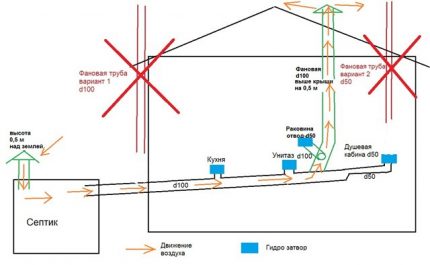
To ensure good ventilation, it is necessary to ensure the flow of air into the second chamber, where the process of processing waste biomass aerobic bacteria.
As for the first chamber, only the main sewage pipeline is connected to it.
Choosing a ventilation location
On most septic tank ventilation schemes, the pipe in the form of a straight vertical is displayed high above the roof, directly above the bathroom. In real life, it is quite difficult to make an extract from the septic tank, since it is not always possible to hold a pipe without bends. In two-story private houses the task is even more complicated, because often there is a living room above the bathroom, which I would not want to spoil with such an “ornament”.
It is not recommended to install the ventilation pipe under a canopy or cornice. Otherwise, water, snow or ice will get inside the system. Also, do not take the pipe to the attic, as incandescent gases will spread to the lower floors.
The best option is to install a straight plastic pipe directly in the center of the roof, so that the ventilation system will be protected from rain.
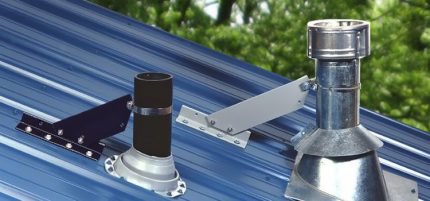
If the pipe is removed in an unsuitable part of the roof, a hood can be installed to protect it from rain. To prevent insects and small rodents from getting into the pipe, it is enough to install a fine metal mesh.
You can protect the pipe from freezing by thermal insulation with mineral wool or foamed polyethylene.
Installation of ventilation risers
During the construction of ventilation, it is recommended to install the riser at the beginning of the sewer distribution. This is necessary so that vacuum does not form in the pipe when flushing water. Its strength may be quite enough for the involuntary opening of a water lock in the bathroom.
Installing a ventilation inlet at the very beginning of the wiring will help to avoid catastrophic consequences, whereby the vacuum will be successfully compensated.
With proper installation of the ventilation of the septic tank, the air inflow is carried out in the second septic chamber, passes through all the pipes, and is discharged above the roof of the house. If everything is done according to the rules, then the inhabitants of the house will not notice unpleasant odors coming from the ventilation pipe on the roof.
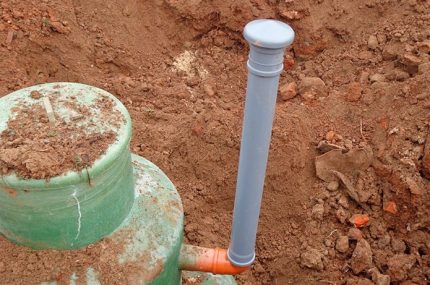
If the sewer system consists of cast iron parts, then it is best to immediately replace them with more practical plastic pipes. In fact, you will need to dismantle the old system, and reassemble the sewer network, but from special PVC pipes.
This will take a little longer, but will help to avoid the problem of overgrowing pipes in the future, as a result of which double work will have to be done.
Conclusions and useful video on the topic
Visual instruction for the proper construction of a septic tank ventilation is presented in the following video:
From this video you will learn how to independently make an effective septic tank for outdoor sewage:
The sewer system in a private house must necessarily be equipped with ventilation, which allows timely removal of gases that are formed during the processing of waste biomass. This will help not only protect your home from unpleasant odors coming from the bathroom or toilet, but also increase the efficiency of wastewater treatment.
Despite the fact that the construction of a ventilation system for septic tanks is the final process, the design of the system is carried out in advance.
If you previously had to install the septic tank ventilation yourself, please share your experience with our readers. Tell us which type of ventilation you chose, what difficulties you had to face during the construction process.You can leave your comment immediately after the article, in the field provided for this purpose.

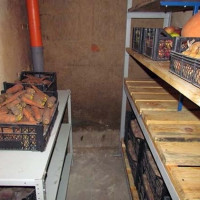 Do-it-yourself ventilation of the cellar in the garage: installation methods and procedures + useful tips for arranging
Do-it-yourself ventilation of the cellar in the garage: installation methods and procedures + useful tips for arranging 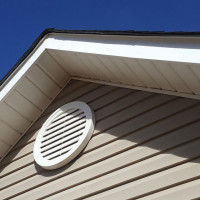 Ventilation in a private house through the pediment: arrangement options
Ventilation in a private house through the pediment: arrangement options  Basement ventilation in a private house: the best ways to arrange proper air exchange
Basement ventilation in a private house: the best ways to arrange proper air exchange 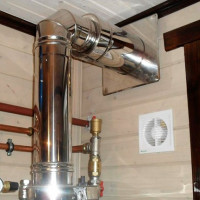 Ventilation for a gas boiler in a private house: arrangement rules
Ventilation for a gas boiler in a private house: arrangement rules 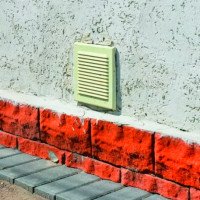 Underfloor ventilation in a private house: solution options and practical implementation methods
Underfloor ventilation in a private house: solution options and practical implementation methods  Attic ventilation in a private house: rules and devices for organizing air exchange
Attic ventilation in a private house: rules and devices for organizing air exchange  How much does it cost to connect gas to a private house: the price of organizing gas supply
How much does it cost to connect gas to a private house: the price of organizing gas supply  The best washing machines with dryer: model rating and customer tips
The best washing machines with dryer: model rating and customer tips  What is the color temperature of light and the nuances of choosing the temperature of the lamps to suit your needs
What is the color temperature of light and the nuances of choosing the temperature of the lamps to suit your needs  Replacement of a geyser in an apartment: replacement paperwork + basic norms and requirements
Replacement of a geyser in an apartment: replacement paperwork + basic norms and requirements